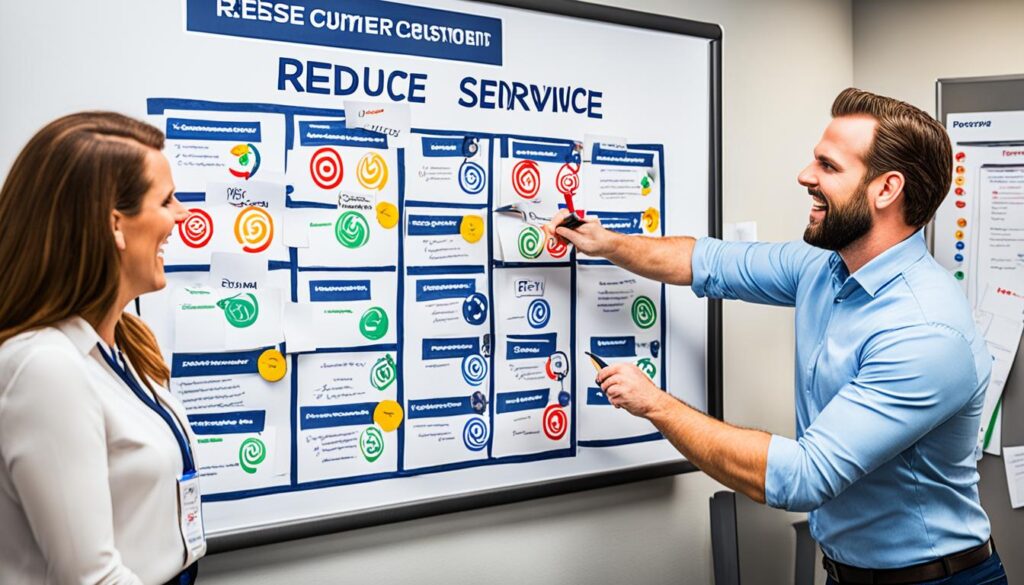Setting individual customer service goals is essential for enhancing customer service and driving team performance. By setting SMART goals that are Specific, Measurable, Achievable, Relevant, and Time-bound, you can ensure that your goals are effective and motivate your team to achieve them. Customer service goals align everyone’s actions, improve customer satisfaction, reduce wait time, and reduce costs. In this article, we will explore how to set effective customer service goals and provide examples of specific goals to help you improve your customer service.
Key Takeaways:
- Setting individual customer service goals is crucial for enhancing customer service and driving team performance.
- SMART goals are Specific, Measurable, Achievable, Relevant, and Time-bound.
- Customer service goals align everyone’s actions and improve customer satisfaction.
- Examples of specific goals can help you improve your customer service.
Why You Need Customer Service Goals
Setting customer service goals is essential for the success of your team and the improvement of your customer service. By establishing clear goals, you provide direction and focus for your team members, enabling them to work towards a common objective.
One of the key benefits of setting goals is that they help improve team performance. By setting specific targets, you create opportunities for feedback and evaluation, allowing your team to identify areas for improvement and take proactive measures to enhance their performance. Goals also provide benchmarks for individual agents to measure themselves against, motivating them to consistently deliver high-quality customer service.
Moreover, customer service goals align everyone’s actions within your team. When everyone knows what they are working towards, it ensures a unified effort and aligns individual actions with the broader objectives of the business. This alignment not only improves the overall team performance but also contributes to the continuous improvement of customer service.
In summary, having customer service goals is vital for managing team performance, driving improvement, and achieving business success. By setting and working towards these goals, you can align actions, improve customer service, and ensure that your team consistently delivers exceptional experiences to your customers.

The Benefits of Setting Customer Service Goals
- Improved team performance and productivity
- Enhanced customer satisfaction and loyalty
- Greater alignment of actions within the team
- Increased motivation and engagement among team members
- Opportunities for feedback and evaluation
- Clear benchmarks for measuring success
- Continued focus on improving customer service
How to Set Effective Goals
Not all goals are created equally. To set effective goals, they need to follow the SMART philosophy: Specific, Measurable, Achievable, Relevant, and Time-bound. Specific goals are more motivating and provide clarity. Measurable goals enable you to track progress and determine when they have been achieved. Achievable goals are realistic and within reach of your team’s current resources and skills. Relevant goals align with your organization’s mission and provide a clear benefit. Time-bound goals have a deadline that creates a sense of urgency and helps evaluate progress. Following the SMART framework ensures that your goals are effective and impactful.
Specific Goals
Setting specific goals is crucial for providing clarity and motivation to your team. Rather than setting vague goals, such as “improve customer service,” be specific about what you want to achieve. For example, a specific goal could be “Increase customer satisfaction ratings by 10% within six months.”
Measurable Goals
Measurable goals allow you to track progress and determine whether you have achieved them. By setting measurable goals, you can objectively assess your team’s performance. For example, a measurable goal could be “Respond to customer inquiries within 24 hours.”
Achievable Goals
Setting achievable goals is important to ensure that they are realistic and within reach of your team’s current resources and skills. It’s essential to set goals that motivate your team without overwhelming them. For example, an achievable goal could be “Reduce customer wait time by 20% within three months.”
Relevant Goals
Relevant goals are aligned with your organization’s mission and values. They provide a clear benefit and contribute to the overall success of the business. When setting goals, consider how they align with your organization’s priorities. For example, a relevant goal could be “Increase customer retention rate by implementing a loyalty program.”
Time-bound Goals
Setting time-bound goals creates a sense of urgency and helps evaluate progress. Deadlines provide a clear timeframe for achieving the goals and keep your team focused. For example, a time-bound goal could be “Launch a new self-service portal within three months.”
By setting effective goals that are specific, measurable, achievable, relevant, and time-bound, you can motivate your team and drive performance. The following table provides an overview of the SMART framework:
| SMART Goal Component | Description |
|---|---|
| Specific | Goals should be specific, clearly defining what you want to achieve. |
| Measurable | Goals should be measurable so that you can track progress and determine success. |
| Achievable | Goals should be realistic and within reach of your team’s current resources and skills. |
| Relevant | Goals should be relevant to your organization’s mission and provide a clear benefit. |
| Time-bound | Goals should have a deadline that creates a sense of urgency and helps evaluate progress. |

Examples of Customer Service Department Goals
As a customer service department, setting strategic goals is essential for enhancing customer satisfaction, improving operational efficiency, and contributing to the overall success of your organization. By aligning your goals with the objectives of the wider organization, you can drive customer service excellence and deliver exceptional experiences to your customers.
Here are some examples of customer service department goals:
- Increase Customer Satisfaction: Implement initiatives and strategies to enhance the overall customer experience, resolve issues promptly, and exceed customer expectations.
- Improve Net Promoter Score (NPS): Focus on increasing NPS by identifying and addressing customer pain points, fostering customer loyalty, and encouraging customers to advocate for your brand.
- Reduce Customer Wait Time: Streamline processes, optimize resource allocation, and leverage technology to minimize customer wait times, ensuring efficient and prompt service delivery.
- Reduce Cost per Contact: Implement cost-saving measures such as self-service options, knowledge base improvements, and proactive issue resolution to minimize the cost associated with customer interactions.
- Track Channel-Specific Metrics: Set goals specific to different customer service channels (such as phone, email, chat, social media) to monitor and improve performance, ensuring consistent service across all touchpoints.
These goals serve as guidances to your customer service department, driving improvements in customer satisfaction, operational efficiency, and cost management. By continuously evaluating and refining these goals, you can adapt to changing customer needs and expectations, ensuring ongoing success for your organization.

Examples of Customer Service Manager Goals
As a customer service manager, your role is to provide exceptional support to customers while leading and developing your team. To achieve these objectives effectively, it is essential to set clear and actionable goals. Here are some examples of customer service manager goals that can help you enhance the quality of service and drive team performance:
1. Increase Quality of Responses: Implement strategies to enhance the quality and accuracy of responses provided by your team members. This includes ensuring that they understand customer needs, provide thorough and personalized solutions, and maintain a professional tone in all interactions.
2. Prioritize Team Development: Focus on the growth and development of your team members. This can involve providing ongoing training, coaching, and mentorship to improve their customer service skills, product knowledge, and problem-solving abilities. Encourage continuous learning and create individual development plans for each team member to foster their professional growth.
3. Improve Team Performance: Set performance metrics and goals for your team to improve their efficiency and effectiveness. Monitor key performance indicators such as response time, customer satisfaction ratings, and first contact resolution rate. Regularly review team performance, provide feedback, and implement strategies to address any performance gaps and improve overall team productivity.
4. Enhance Customer Experience: Implement initiatives and strategies to enhance the overall customer experience. This includes analyzing customer feedback, identifying pain points, and implementing improvements to processes, policies, and systems. Encourage a customer-centric culture within your team and empower team members to go above and beyond to exceed customer expectations.
5. Implement New Strategies: Stay updated with industry trends and customer expectations. Implement new technologies, tools, and strategies that can improve the efficiency and effectiveness of your customer service operations. This can involve adopting new communication channels, implementing chatbots or AI-powered solutions, or leveraging customer data to personalize interactions.
To further illustrate these goals, here is a table providing specific examples:
| Goal | Description |
|---|---|
| Increase Quality of Responses | Implement quality assurance programs and conduct regular performance evaluations to improve the accuracy and effectiveness of customer service responses. |
| Prioritize Team Development | Provide ongoing training, coaching, and professional development opportunities for team members to enhance their customer service skills and career growth. |
| Improve Team Performance | Set performance targets, monitor key metrics, and provide feedback to drive continuous improvement and boost team productivity. |
| Enhance Customer Experience | Analyze customer feedback, identify pain points, and implement strategies to improve processes and deliver exceptional customer experiences. |
| Implement New Strategies | Stay updated with industry trends, adopt new technologies, and explore innovative approaches to enhance customer service operations. |
By setting these goals and implementing effective strategies, you can lead your team towards providing exceptional customer service, achieving customer satisfaction, and contributing to the overall success of your organization.
Importance of Continuous Improvement
Continuous improvement is a fundamental aspect of delivering exceptional customer service. By continuously striving to meet and exceed customer expectations, you can ensure long-term satisfaction and loyalty. To achieve continuous improvement, it is crucial to gather and analyze customer feedback, implement quality assurance processes, provide training and development opportunities for your team members, and conduct ongoing evaluations of performance.
Customer feedback serves as a valuable source of insights and allows you to identify areas for improvement. By listening to your customers’ needs and addressing their concerns, you can enhance your service offerings and strengthen customer relationships.
Implementing quality assurance processes ensures that your services consistently meet high standards. By setting quality benchmarks and regularly evaluating performance against these benchmarks, you can identify areas of improvement and take proactive measures to enhance the quality of your service delivery.
Investing in the training and development of your team members is essential for continuously improving customer service. By equipping your employees with the necessary skills and knowledge, you empower them to deliver exceptional service experiences and handle customer inquiries with confidence and expertise.
Ongoing evaluation plays a crucial role in continuous improvement. By regularly assessing individual and team performance, you can identify strengths and areas for growth. This evaluation allows you to provide targeted feedback and implement strategies to address any performance gaps or areas that require improvement.

Benefits of Continuous Improvement
- Enhanced customer satisfaction: Continuous improvement ensures that you consistently meet and exceed customer expectations, resulting in high levels of satisfaction.
- Increased operational efficiency: By identifying and addressing inefficiencies, you can streamline processes and improve productivity.
- Improved employee morale: Emphasizing continuous improvement shows your commitment to your team’s growth and development, leading to increased job satisfaction.
- Competitive advantage: By continually refining your customer service strategies, you can differentiate yourself from competitors and attract more customers.
- Enhanced customer loyalty: Consistently delivering exceptional service experiences fosters loyalty among your customer base, leading to repeat business and positive word-of-mouth referrals.
| Continuous Improvement Strategies | Benefits |
|---|---|
| Regularly collect and analyze customer feedback | Identify areas for improvement and address customer concerns |
| Implement quality assurance processes | Ensure service delivery meets high standards consistently |
| Provide ongoing training and development | Empower employees to deliver exceptional service experiences |
| Evaluate individual and team performance | Identify strengths and areas for growth |
Conclusion
Setting individual customer service goals is a powerful strategy to enhance the customer experience, drive team performance, and achieve business success. By following the SMART framework and focusing on specific, measurable, achievable, relevant, and time-bound goals, you can ensure that your goals are effective and motivating for your team.
Continuous evaluation and refinement of your customer service goals are essential to adapt to changing customer needs and expectations. By staying proactive and responsive, you can provide exceptional service and exceed customer expectations.
With effective customer service goals in place, you can create a customer-centric culture within your organization, where everyone is aligned and committed to delivering outstanding results. By enhancing the customer experience, driving team performance, and achieving business success, you position your organization as a leader in the industry and build valuable customer relationships.
FAQ
Why is setting individual customer service goals important?
Setting individual customer service goals is important because it provides direction and focus for your team, improves team performance, aligns actions, and gradually improves customer service.
What is the SMART philosophy for setting effective goals?
The SMART philosophy stands for Specific, Measurable, Achievable, Relevant, and Time-bound goals. Following this framework ensures that your goals are effective and impactful.
What are some examples of customer service department goals?
Examples of customer service department goals include increasing customer satisfaction, improving net promoter score, reducing customer wait time, reducing cost per contact, and setting channel-specific goals.
What are some examples of customer service manager goals?
Customer service manager goals may include increasing the quality of responses, prioritizing team development, improving team performance, enhancing the customer experience, and implementing new strategies.
Why is continuous improvement important in customer service?
Continuous improvement is important in customer service because it allows you to identify areas for improvement, refine your strategies, and ultimately deliver exceptional customer experiences.
How do I set effective customer service goals?
To set effective customer service goals, use the SMART framework and ensure that your goals are specific, measurable, achievable, relevant, and time-bound.
How do customer service goals contribute to business success?
Setting individual customer service goals enhances customer experience, drives team performance, and ultimately contributes to the overall success of the business.
